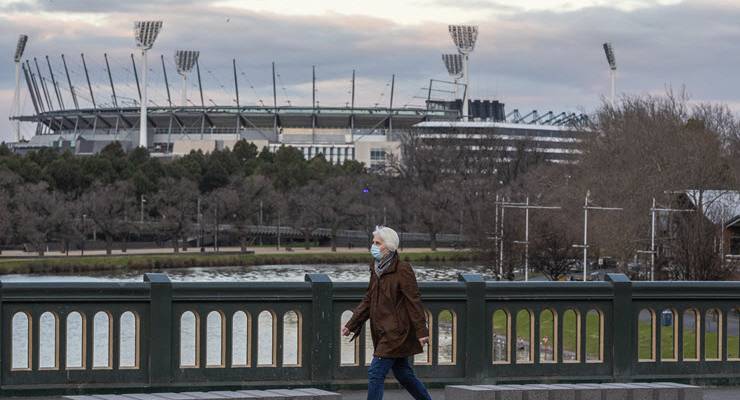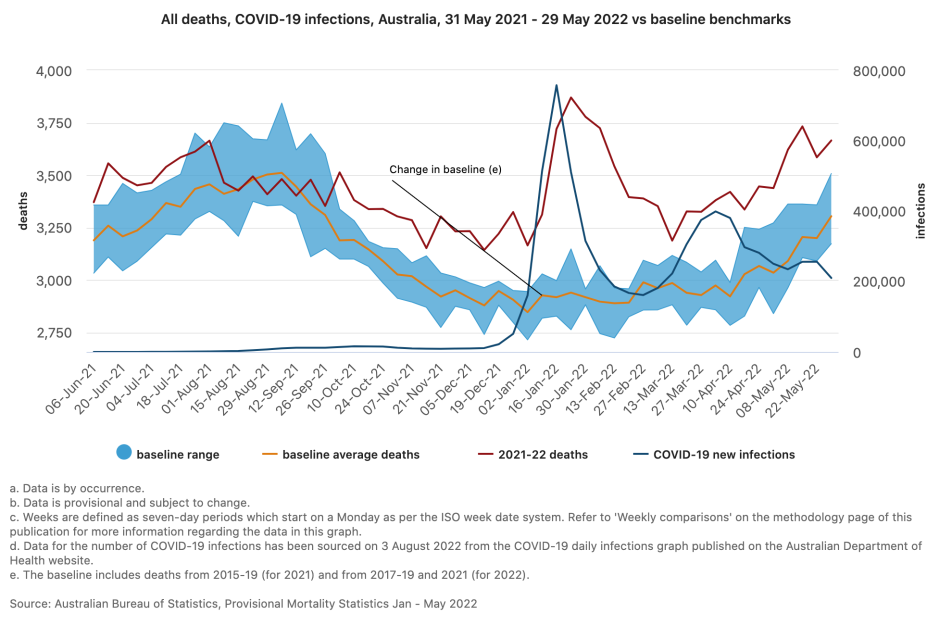
Australia has seen extraordinarily high death rates this year, and COVID-19 isn’t the sole cause, data released by the Australian Bureau of Statistics shows.
More than 4400 people died from COVID between January to May, most during the dramatic spike in infections and deaths that began in the new year and peaked on January 23. Numbers of COVID deaths returned only briefly to 2021 levels in March before taking off again as policymakers and the public collectively decided that the pandemic was over.
In the week after the federal election, COVID deaths returned to 200 a week.
But deaths from other causes have also surged. The ABS constructed a baseline for numbers of deaths based on 2017-21 deaths, leaving out 2020 because of the pandemic (with lockdowns dramatically lowering death numbers that year):
- Deaths due to dementia were 16% above the baseline in the month of May, and 20% above the baseline from January to May
- Deaths from cancer were 5.5% higher in May and 6% higher in the January-May period
- Deaths from diabetes were nearly 19% higher in May and 20% higher in the January-May period
- There ere also significantly more influenza deaths, but pneumonia deaths were actually down for comparable periods.
The overall result was about 10,700 more deaths compared with baseline periods for the January-May period, or about 16% more. The age-standardised death rate in May was also higher: 45.9 deaths per 100,000 compared with the average of 44.2.

It’s still too soon to look at excess mortality for the period — the ABS will provide that later — but the data suggests the impacts on lockdown in reducing mortality from COVID and other causes (flu, car accidents etc) may yet be balanced by deaths from chronic conditions or illnesses that received less medical attention — beyond those resulting from our collective decision that we no longer had to take COVID seriously as a threat to life.








The alternative explanation for the higher level of deaths from other causes is actually surely covid itself both directly and indirectly, rather than lockdown impacts.
First the evidence that each infection weakens the immune system, making people more vulnerable to death from other causes, is now very strong. And with the high level of covid cases in nursing homes in particular, it can surely be expected that a high proportion of those who survive initial infection(s) will then be more susceptible to death from other causes, hence the increase in dementia and influenza in particular.
Secondly, there is also strong data that people infected with covid are then subsequently far more likely to develop diabetes, cardiovascular issues, and other diseases, and suffer increased rates of mortality as a result.
And if there is an impact from reduced access to medical treatment, the current collapse of our primary health care system, leading to long waits to get access to specialists in particular, due to covid infection and particularly long covid amongst health workers, combined with the huge increase in hospitalisations generally, is likely to be far more of a culprit than lockdowns.
A nursing home would have a regular doctor on call, and the home’s management would have preferred “Alzheimers” to “Covid” on the death certificate. It’s a symbiotic relationship.
I am one of those who could have died from my almost asymptomatic pneumococcus pneumonia. The lesion in my lung was 3cm and walled off.
I ignored the fatigue which was put down to any one of my autoimmune diseases.
I went for my annual trip to the snow and found it difficult to get enough oxygen at altitude. This was normal for me for about 3 days then it continued, not normal.
I stayed in my room and had negative RAT’s.
It wasn’t until I fainted in the shower that confirmed I was sick.
Down from the mountain, having fallen from the over snow transport, the last step was at my waist height and the ice I landed on was hard. No one assisted me back onto my feet, thank you Charlotte Pass Over snow.
A respiratory arrest at the Wesley Emergency Centre got me an isolation bed, 2 specialists wondering if I had TB.
It was something which was going to kill me, if not treated.
I am so sorry that you have been unwell, and hope you have made a good recovery. It’s guest that you are well enough to contribute here.
Not wanting to sound insensitive, but is another factor demographic decline due to oldies born in 20s & 30s now departing, before what has been described as ‘the big die off’ of baby boomers commences?
Australians have become so conditioned by media reports, helped by ‘Australia’s best demographer’ et al., that we have high (undefined) immigration and ‘population growth’ aka ZPG environmental ‘hygiene’ issues, that decline seems ‘counter intuitive’ (according to Bricker & Ibbitson)?